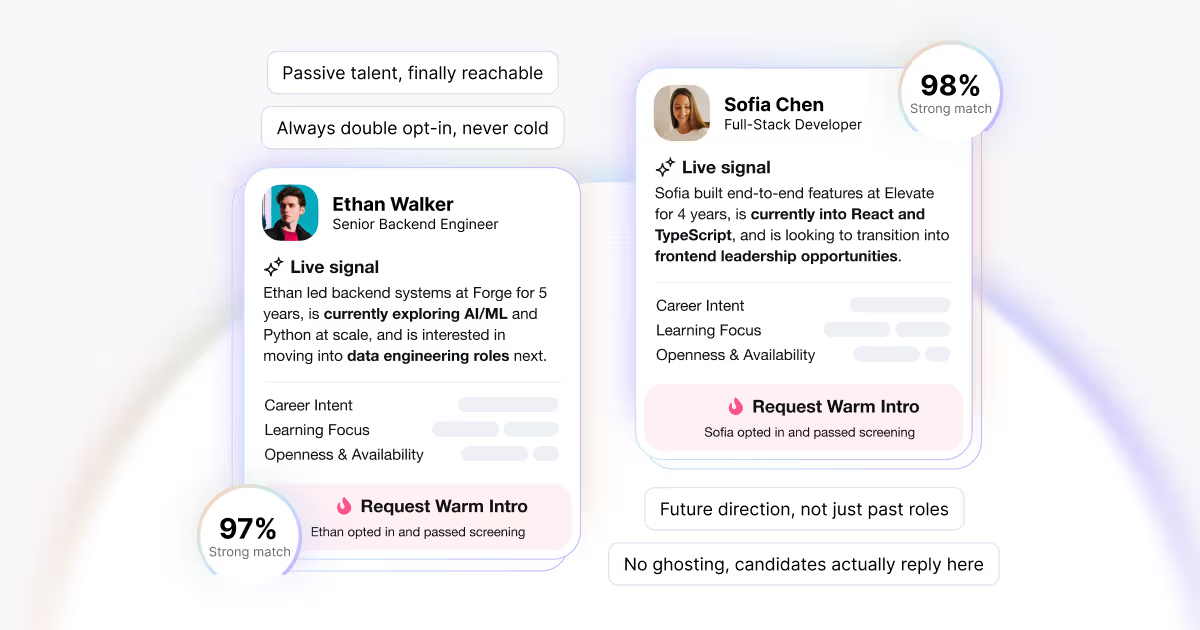


Recruiters can effectively engage passive developers by personalizing outreach, providing clear job details, and building trust through meaningful communication.
Most recruiters fail to connect with passive developers because they use the wrong approach. Passive developers - those not actively looking for jobs - are selective and require personalized, meaningful outreach to engage. Generic messages, vague job descriptions, and pushy follow-ups are the main reasons recruiters get ignored.
To succeed, recruiters need to:
- Personalize outreach: Reference specific skills, projects, or achievements.
- Be transparent: Share clear job details like salary, tech stack, and team structure.
- Limit follow-ups: Avoid excessive messaging that feels intrusive.
- Build trust: Focus on long-term relationships rather than quick hires.
Who Passive Developers Are and What They Want
Defining Passive Developers
Passive developers are professionals who are currently employed and not actively searching for new jobs, but they might be open to the right opportunity if it aligns with their career goals. Picture that skilled engineer you know who seems content in their role but could be intrigued by an offer that fits naturally with their aspirations.
These developers aren’t spending their time scrolling through job boards or perfecting their resumes. Instead, they focus on honing their skills and excelling in their current roles. However, this doesn’t mean they’re completely closed off to new possibilities - they’re just highly selective. While active job seekers often respond out of necessity, passive developers engage only when an outreach truly resonates with them.
To connect with passive developers, it’s crucial to understand what motivates them - and what doesn’t.
What Drives and Deters Passive Developers
For passive developers, switching jobs isn’t about making just any move. They’re driven by opportunities that promise genuine career growth. This could mean promotions, taking on greater responsibilities, or learning sought-after skills that enhance their professional trajectory. They’re not interested in lateral moves; they want to see a clear path forward.
Compensation plays a major role, too. For these developers, a significant salary increase is necessary to justify the effort and disruption of changing roles. A small bump in pay won’t cut it - there needs to be a compelling financial incentive.
Work-life balance and flexibility are equally important. Many developers highly value remote work options or other arrangements that allow them to maintain a healthy personal life. Once they’ve found a setup that works for them, they’re unlikely to consider opportunities that might upset that balance.
Another critical factor is how they’re approached. Impersonal, generic messages are a major turn-off. Here’s a telling statistic: 90% of passive developers in daily.dev's network ignore outreach from other platforms. On the other hand, double opt-in introductions - where developers can review a personalized opportunity before deciding to engage - yield reply rates of over 85–90%.
This strong preference for control highlights the need for recruiters to align their outreach strategies with what passive developers value most. By understanding these motivations and avoiding common pitfalls, recruiters can better connect with this selective group.
The SECRET to Winning Over Passive Job Candidates
Where Recruiters Go Wrong
Recruiters often struggle to connect with passive developers, not because these professionals are unreachable, but because the methods used to approach them frequently miss the mark. These missteps create instant barriers to trust and engagement. Recognizing and addressing these common errors is crucial for building authentic connections with passive talent.
Using Generic Messages
One of the most common mistakes recruiters make is relying on generic, mass-targeted messages. Nothing turns developers off faster than receiving a cookie-cutter message like, "We have an exciting opportunity for you!" - especially when it lacks any mention of their specific skills or career path. Messages like this scream "mass outreach" and make developers feel like just another name on a list.
When recruiters fail to acknowledge a developer’s unique background, work, or interests, it signals a lack of effort. This is especially frustrating for passive developers who aren’t actively job hunting and are unlikely to engage without a compelling, personalized pitch.
The numbers back this up: personalized messages can boost response rates by as much as 300%, while generic outreach often falls below a 10% response rate. Think about the difference between these two approaches:
- Generic message: "Hi, I have a great software engineer role that would be perfect for you."
- Personalized message: References the developer’s recent projects, highlights relevant technologies, or acknowledges specific achievements.
Beyond personalization, another common pitfall involves leaving out critical job details.
Providing Vague Job Details
Passive developers need clear, compelling reasons to consider leaving their current roles. Unfortunately, many recruiters send job descriptions that are too vague, making it impossible for developers to evaluate whether the opportunity is worth exploring.
For example, phrases like "competitive salary" are far less effective than specifying a range, such as "$140,000–$160,000 annually." Similarly, a job description that fails to detail the tech stack or project scope leaves developers guessing about whether the role aligns with their expertise and interests.
Passive candidates aren’t actively looking for a job, so they need to see real value in making a change. Developers want to know specifics: What technologies will they work with? What projects will they tackle? Who will they collaborate with? What’s the salary? Without these details, they’re unlikely to engage.
The best recruiters address this by being upfront and transparent. They share comprehensive information about the role, including:
- The exact tech stack
- Team size and dynamics
- Project details
- Salary range in USD
- Benefits and growth opportunities
This level of detail not only helps developers quickly assess whether the role is a good fit but also shows respect for their time and decision-making process. Another area where recruiters often stumble is in their follow-up strategy.
Sending Too Many Messages
Over-communication is a common mistake that can harm a recruiter’s credibility. Bombarding developers with multiple follow-ups - especially when there’s no new information to share - can come across as pushy rather than persistent. When recruiters continue to reach out after receiving no response, they risk being seen as intrusive or even spammy.
For passive developers, who aren’t actively seeking new roles, excessive messaging can be particularly irritating. Unsolicited messages disrupt their workflow, and repeated contact without added value feels disrespectful of their time.
This problem is often worsened by automated sequences that send follow-ups regardless of whether the developer has engaged. Imagine receiving several nearly identical messages in a short period - it’s no surprise that this approach erodes trust and can lead to developers blocking or reporting recruiters.
The most effective recruiters focus on quality over quantity. They limit their outreach to two or three well-thought-out messages, spaced appropriately. If a developer doesn’t respond after personalized and genuine attempts, they know when to move on. This approach not only preserves professional relationships but also ensures they maintain their credibility in the long run.
How to Engage Passive Developers
Engaging passive developers effectively requires a shift from a numbers game to a more thoughtful, quality-driven approach. Instead of bombarding developers with generic messages, the focus should be on building meaningful connections through personalized and value-centered communication.
Writing Personalized, Detailed Messages
The first step in connecting with passive developers is crafting messages that feel personal and relevant. This means doing your homework. Dive into their recent projects, open-source contributions, or even talks they’ve given, and use that information to tailor your outreach.
A personalized message should reference specific details about the developer's work and clearly explain why the opportunity suits their skills and interests. For instance, instead of a vague, “I have a great opportunity for a senior developer,” you could write something like:
"Your recent work on microservices architecture at [Company] really impressed me. We’re looking for someone with your expertise in Kubernetes and Docker to help scale our platform."
Additionally, make sure your job descriptions resonate with developers by addressing the technical challenges they’ll tackle and setting clear expectations.
Creating Developer-Focused Job Descriptions
Generic job descriptions often fail to grab a developer's attention. Developers want to know what problems they’ll solve, the tools they’ll use, and how their work will make a difference.
Instead of starting with a bland company overview like, "We’re a fast-growing company looking for talented developers," try something more engaging:
"We’re designing a distributed system to handle real-time data processing for 50,000+ concurrent users."
Keep the focus on technical clarity. Highlight 3–4 core technologies essential to the role. For example, mentioning "React and Node.js for building customer dashboard features" is far more effective than listing every technology under the sun.
Be honest about the work environment and processes. Developers value insights into things like code reviews, testing practices, deployment frequency, and how technical documentation is handled. These details help them gauge whether the role aligns with their work style.
Realistic requirements also play a big role. Overloading job postings with a laundry list of "required" skills - when only a few are genuinely necessary - can deter even highly qualified candidates. Instead, focus on the must-have skills that truly matter for success in the role.
Finally, connect the dots between the developer’s contributions and the bigger picture. Show them how their work will impact the company or its users, like:
"The features you build will directly enhance customer success by improving platform reliability and user experience."
Once you’ve nailed the personalization and job description, warm introductions can help seal the deal.
Using Warm Introductions
Cold outreach often feels intrusive, but warm introductions create a smoother path to engagement. Platforms like daily.dev Recruiter are great for enabling double opt-in introductions, ensuring both parties are interested before starting a conversation.
With a warm introduction, you’re starting from a place of mutual interest. Developers who’ve already expressed curiosity about opportunities in their field are far more likely to engage in meaningful discussions. This approach not only respects their time but also ensures that you’re presenting roles aligned with their goals. It’s a trust-driven strategy that makes the process feel collaborative rather than disruptive.
sbb-itb-d1e6221
Building Ongoing Relationships with Passive Developers
Once you've captured the interest of passive developers, the next challenge is maintaining those connections. Building lasting relationships is essential for converting passive candidates into active ones. Since 37.3% of American job seekers are open to new opportunities and another 29.4% aren't actively searching, staying connected is key to tapping into this substantial talent pool.
The focus should be on moving away from transactional recruiting and toward relationship-building that genuinely benefits developers’ careers.
Building Company Credibility
Trust is at the heart of forming meaningful relationships with passive developers. With half of all candidates unwilling to work for companies with poor reputations - even for higher pay - your company's credibility plays a huge role in attracting top talent. Companies with strong brands tend to receive twice as many job applications compared to those with weaker reputations.
To build trust, showcase your company’s expertise and culture through authentic technical content. This could include blog posts detailing how your team solved complex scaling challenges, contributions to open-source projects, or case studies highlighting impactful work.
Transparency is another way to earn trust. Share details about your development practices, such as how you approach code reviews, testing, and deployment cycles. Developers value honesty about both successes and challenges - this openness resonates with them.
Engage in the spaces where developers already spend their time. Whether it’s participating in online forums, contributing to open-source initiatives, or speaking at conferences, your team can demonstrate expertise while building connections. Publishing technical articles or sharing insights further reinforces your company’s commitment to the developer community.
It’s also important to highlight your company culture. Share stories about how your team collaborates, overcomes obstacles, and supports each other’s professional growth. Real examples of career progression and how your company supports transitions can make a lasting impression.
Once you’ve established credibility, nurturing these relationships consistently can transform initial interest into a long-term talent pipeline.
Maintaining a Developer Talent Pipeline
A well-maintained talent pipeline ensures you always have a pool of pre-qualified candidates. With 72% of CEOs identifying the availability of key talent as a top challenge, ongoing connections with passive developers provide a significant edge.
Personalized communication is essential. Regularly check in with developers to discuss their career goals and achievements. Reference past conversations and celebrate milestones like promotions, certifications, or work anniversaries.
Another effective way to stay connected is through content sharing. Provide value by offering technical tutorials, industry insights, and career resources. Examples include salary trends, emerging technologies, or guidance on career paths in their field. By doing this, you position yourself as a trusted resource, not just someone who reaches out when a job opens up.
Segmenting your talent pool by technology, seniority, and location allows for more targeted engagement. This ensures that the opportunities and content you share align with their specific interests and career stage.
Creating spaces for developers to connect with peers and your team can also strengthen relationships. Platforms like Slack groups, meetups, or mentorship programs foster a sense of community. When developers see value in these communities, they’re more likely to consider opportunities with your company.
Maintaining a pipeline isn’t just about filling roles - it’s about mutual benefit. Offer career growth support beyond job placement, such as resume reviews, mock interviews, or networking opportunities. These efforts can help developers advance their careers while building goodwill that often leads to future opportunities or referrals.
A warm, active pipeline doesn’t just improve candidate quality - it can also reduce time-to-hire (averaging 41 days) and lower hiring costs (around $4,700). By investing in these ongoing relationships, you create a sustainable and efficient recruitment strategy.
Tracking and Improving Outreach Results
Understanding how your recruitment efforts perform is essential for connecting with passive developers. By focusing on meaningful metrics and leveraging feedback, you can refine your outreach strategy and achieve better results.
Key Metrics to Watch
Once you’ve implemented your engagement strategies, the next step is measuring their impact. Here are the metrics that matter most:
- Reply rates: This metric shows how effective your outreach is. Track how different message templates, subject lines, and channels perform to identify what resonates with developers.
- Response quality: The type of replies you receive matters just as much as the quantity. Categorize responses into groups like "interested", "open to future opportunities", or "non-responsive" to better understand engagement levels.
- Time to response: Quick replies can indicate that your messaging is compelling. Tracking how long it takes developers to respond helps gauge the immediate appeal of your outreach.
- Interview conversion rates: If replies aren’t translating into interviews, it may signal that your follow-up process needs work. This metric helps refine how you nurture interested candidates.
- Hire quality and retention: The ultimate goal is to bring in talented developers who stay and thrive. Monitor how long recruits remain with your company and assess their performance to identify the most effective outreach methods.
- Cost per hire: Calculate the total cost of recruiting passive candidates, including time spent on research, outreach, and relationship building. While passive recruiting may require more upfront investment, the quality of hires can make it worthwhile.
Tools like daily.dev Recruiter can simplify tracking these metrics by offering built-in analytics. With features like warm, double opt-in introductions, these platforms often lead to higher engagement because developers have already expressed interest in staying connected.
Beyond the numbers, direct feedback is a powerful way to improve your strategy.
Using Feedback to Evolve
Gathering feedback from both developers and hiring managers is crucial. For example, after a rejection, you could send a short survey asking, "What information would have made this role more appealing?" Similarly, consult hiring managers when candidates drop out to understand their perspective. This feedback can help refine job descriptions and adjust your follow-up approach.
A/B testing is another effective way to find what works. Experiment with different subject lines, message lengths, or levels of personalization when reaching out to similar developer profiles. This testing can reveal which tactics lead to better engagement.
Regular team reviews are also valuable. These sessions can help identify patterns in your outreach efforts, and documenting these insights in playbooks ensures your strategies are repeatable and scalable. Additionally, analyzing the tech stacks of engaged developers may uncover trends - like higher response rates from developers experienced in specific technologies - that can sharpen your targeting.
Every interaction is a chance to learn. By consistently monitoring important metrics and incorporating feedback, you can transform your passive outreach into a thoughtful, relationship-driven process. This approach not only attracts top-tier candidates but also provides deeper insights into how to improve your messaging and overall strategy.
Conclusion: Converting Passive Developers into Candidates
Turning passive developers into active candidates requires moving beyond generic outreach and focusing on building meaningful, relationship-driven connections. It's important to remember that 75% of professionals are passive candidates - they're not actively searching for jobs but are open to the right opportunity when approached with care.
The cornerstone of success lies in personalized outreach. Developers are far more likely to engage when recruiters take the time to understand their unique skills, experiences, and career goals. A one-size-fits-all message simply doesn’t work; it feels impersonal and signals mass communication. Instead, recruiters who invest in researching candidates and crafting messages tailored to their aspirations stand out.
Another critical element is building trust-based relationships. Developers respond well to recruiters who are authentic, transparent about roles and company culture, and respectful of their time and privacy. Trust isn’t built overnight - it requires consistent, genuine communication that prioritizes the individual over the transaction.
A particularly effective approach is leveraging warm introductions. Unlike cold outreach, warm introductions - often facilitated through employee referrals - yield better results. In fact, referrals boast an impressive 46% retention rate. Tools like daily.dev Recruiter take this a step further by enabling double opt-in introductions within established developer communities. This ensures every interaction is context-rich, respectful, and free from spam, aligning with the broader goal of thoughtful and targeted communication.
Finally, maintaining ongoing relationships is key. A candidate who says "no" today might become the perfect fit tomorrow. By following up respectfully and keeping the conversation going, recruiters can build a sustainable talent pipeline and stay top of mind when the timing is right. This approach reinforces the importance of personalization, trust, and long-term engagement in passive recruiting strategies.
FAQs
How can recruiters effectively connect with passive developers without overwhelming them?
To reach passive developers effectively without coming across as intrusive, recruiters should prioritize personalized and considerate communication. Craft messages that demonstrate a clear understanding of their skills, interests, and career aspirations. Skip the generic templates - developers appreciate messages that feel genuine and relevant to their unique journey.
Timing plays a crucial role too. Developers are often more responsive during quieter moments, like evenings or weekends. Beyond just timing, building trust is essential. Engage with developer communities, contribute useful resources, and show consistent involvement. This not only establishes credibility but also creates a sense of respect and connection, making developers more likely to engage in meaningful discussions.
How can recruiters build meaningful, trust-based relationships with passive developers?
Recruiters can win over passive developers by prioritizing authentic, long-term relationships instead of simply pushing job offers. This means taking the time to understand their career aspirations, sharing meaningful insights or helpful resources, and communicating with honesty and respect.
To make an impact, connect with developers on platforms they already trust, such as professional networks or industry-specific communities. By consistently delivering value and tailoring each interaction to feel personal and relevant, recruiters can leave a lasting positive impression. This relationship-focused strategy not only builds trust but also lays the groundwork for stronger connections and mutually beneficial opportunities down the line.
Why is it important to personalize messages when reaching out to passive developers, and what should you include?
Personalizing your outreach matters because it demonstrates that you’ve put in the effort to understand a developer’s unique skills, interests, and career aspirations. This thoughtful approach helps build trust and increases the likelihood that they’ll engage with your message.
When creating personalized messages, include details like their recent projects, technical strengths, or professional interests. Show how the opportunity you’re presenting aligns with their goals or addresses challenges they might be facing. By making your message relevant and showing genuine interest, you can greatly increase the chances of getting a response.






